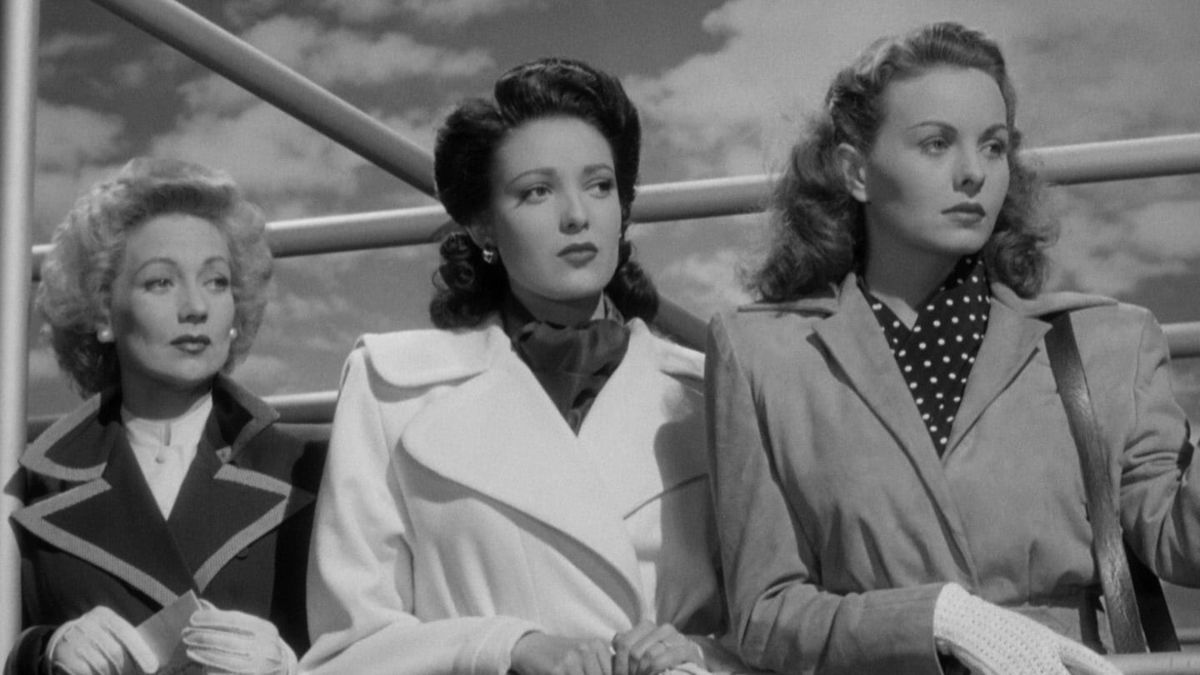I don’t think that I am going out on a limb when I say that World War II changed everything. Among other things, women made it into the workforce, had control over their bodies, and proved they were capable of running their own lives. Needless to say, society (read “men”) was determined to push them away from this new normal as fast as possible.
The movies were certainly complicit in this campaign. During the war years, Hollywood was pumping out a huge number of movies built around strong women. As the end of the conflict was in sight, there was a shift to stories in which women who had exercised their freedom were now shown the evils of mixing in a man’s world. What is 1945’s Mildred Pierce if not a warning to women that business success is fleeting, sexually liberated relationships lead to destruction, and the only true peace comes with a return to hearth and husband?
The late forties shifted this paradigm even further. The noirs told us that powerful femmes were fatale while pretty much every other genre shoved them back into the kitchen. To say that the era presented few images of women as full human beings not defined by the men in their lives would be an understatement of epic proportions.
Maybe this is why Joseph L. Mankiewicz’ A Letter to Three Wives feels just as fresh today as it did over seventy years ago. The women here – Deborah (Jeanne Crain), Rita (Ann Sothern) and Lora Mae (Linda Darnell) are smart, capable and most certainly not created in the image and likeness of their men. Even Deborah, the most seemingly dependent of these, shows she is more than capable of getting by on her own if needed.
The hook in this comedy of manners is as simple as it is deadly: Just as they are about to spend a day in communicado, the three wives receive a letter from their nemesis, Addie Ross, informing them that she has run off with one of their husbands. Trapped on a Hudson River cruise, each woman must examine in flashback which husband it could possibly be. In truth, A Letter to Three Wives has little to do with adultery and everything to do with marriage in the postwar years. It is also a devastatingly funny critique on suburban class structures and the gender roles assigned within.
Each of these three women represents a very different place in the community’s pecking order. Deborah is a poor farm girl now married to Brad (Jeffrey Lynn) and trapped in the upper middle class. Seeking a stable ground between her upbringing and her present circumstances wreaks havoc on her self-image. Rita is a middle class radio writer married to a schoolteacher (Kirk Douglas) who loves his work far too much to seek the upward mobility that his wife craves. Lora Mae is from the wrong side of the tracks – literally – who sets her cap on Porter (Paul Douglas), the boorish but very wealthy retail baron. Whether willing to admit it or not, each of these women is struggling mightily against the class into which they have found themselves as much as they are battling against the one from which they came.
Each story is told in sequence. There is no crosscutting between them although each woman shows up in the other’s story. This allows each tale to grow organically and to have its own comic thrust. It also allows a good number of timebombs, some of which blow up in the final scene while others are left to go off long after the movie is over. One of my favorites of these concerns the Deborah/Brad storyline. In the long run, what will happen to this relationship? Mankiewicz lays out a series of clues both in the direction and in the structure, but cleverly leaves it to us to decide.
This, though, was Mankiewicz’s particular genius. Over the years he would be accused of “a lack of cinema” (whatever that means) and an over-reliance on witty dialogue. Yet in his best work, he proved a superb storyteller, one who saw his job as asking questions rather than providing answers. In this sense, he was reasonably rare among his contemporaries in that he gave his audience credit for its intelligence.
Mankiewicz would famously nab the Oscars for writing and directing A Letter to Three Wives then repeat the same trick the very next year with All About Eve. Accomplishing this, though, should not lead one to think that the two movies are all that similar. Yes, both employ smart dialogue and both place their characters in relief against suffocating enclosed worlds. The fundamental difference, though, is in the size of the characters. All About Eve is all about archetypes. As wonderful as Margo, Eve, Karen and all the other denizens of this Broadway are, they are treated as rarified beings, people of “the theater” and therefore somehow above us mere mortals. The characters of A Letter to Three Wives are as mortal – flawed, silly and craving – as the rest of us. This alone gives A Letter to Three Wives a universality that All About Eve never quite attains.
This point of separation is key: All About Eve’s comments are based on a fantasy of the theater. A Letter to Three Wives finds its commentary in a world that many felt was just outside their front door. In creating the illusion of reality, it poses questions we still seek to answer; questions of class, friendship, marriage, and the positions that have been assigned to us versus the ones we wish to attain.
Sometimes, it takes a great movie to remind us that the more things change, the more they stay the same.


